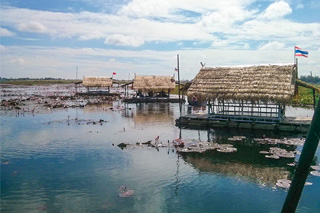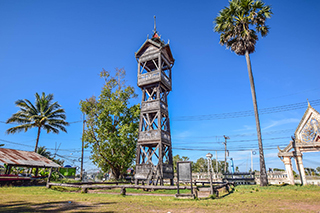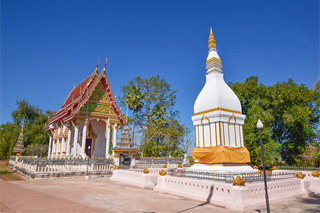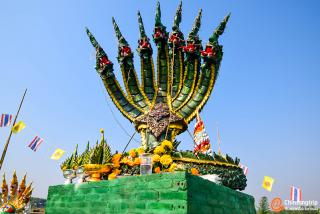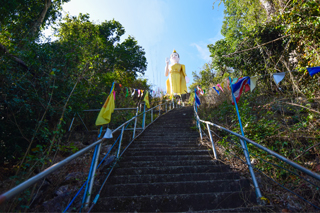The Wooden Bell Tower of Wat Sri Boon Reuang, located in Ban Na Baek, Tambon Wiang Kham, Kumphawapi District, Udon Thani Province, is a symbol of the local culture in the northeastern region of Thailand. It has a long and significant history in the local history and cultural heritage of the area. In the past, the temple was known as "Wat Na Baek" and was constructed in the year 1911.
The architectural style of this Wooden Bell Tower emphasizes the characteristics of the northeastern region, especially during the reconstruction period in the years 1959-1961. It is a wooden bell tower with a rectangular shape, and its roof is divided into three tiers. The lower two tiers are constructed in a trapezoidal shape (four-sided, tapering at the top), adorned with intricate wood carvings depicting branches and captivating patterns.

Characteristics of the Wooden Bell Tower of Wat Sri Boon Reung
With its four-tiered structure, each floor of the bell tower is covered with wooden planks and connected by intricately designed stairs. In constructing the pillars that support the bell tower, there are four pillars, each spaced approximately 2.10 meters apart. Meanwhile, the circumference of the bell tower is around 1.15 meters.
Unfortunately, it is regrettable that the wooden bell tower of Wat Sri Boon Reung has ceased its operational use at present. However, it is still preserved as a valuable piece of architecture, serving as a testament to the importance of preserving the history and culture of the local area for future generations.
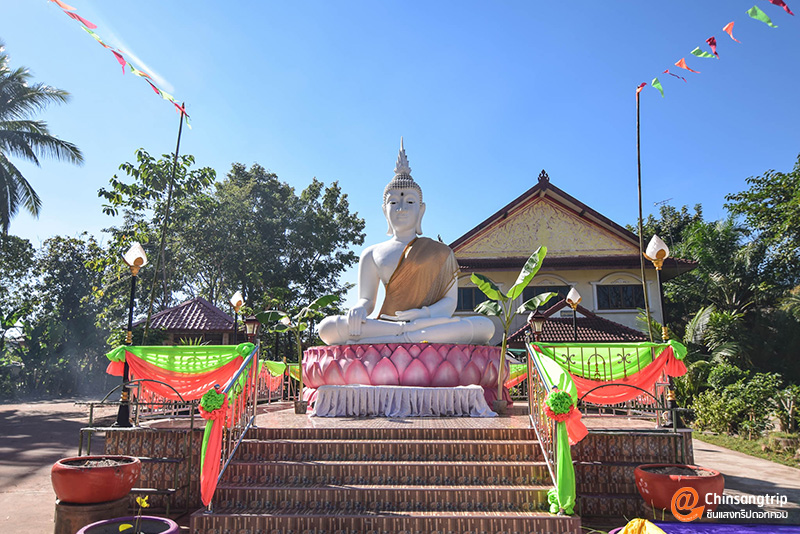
The Fine Arts Department has announced the registration of ancient sites and defined their boundaries as indicated in the Royal Gazette, Volume 116, Special Issue 17ง, dated March 17, 2542 B.E. The registered area covers approximately 3 rai 88 square wah. One significant and interesting location within this area is the "Wooden Bell Tower of Wat Sri Boon Reuang," which is a bell tower constructed from wood and serves as a symbol of Wat Sri Boon Reuang. The registration of this area by the Fine Arts Department designates it as an archaeological site, affirming its historical and cultural significance.
The Wooden Bell Tower of Wat Sri Boon Reuang, located in Ban Na Baek, Tambon Wiang Kham, Kumphawapi District, Udon Thani Province, is a symbol of the local culture in the northeastern region of Thailand. It has a long and significant history in the local history and cultural heritage of the area. In the past, the temple was known as "Wat Na Baek" and was constructed in the year 1911.
The architectural style of this Wooden Bell Tower emphasizes the characteristics of the northeastern region, especially during the reconstruction period in the years 1959-1961. It is a wooden bell tower with a rectangular shape, and its roof is divided into three tiers. The lower two tiers are constructed in a trapezoidal shape (four-sided, tapering at the top), adorned with intricate wood carvings depicting branches and captivating patterns.

Characteristics of the Wooden Bell Tower of Wat Sri Boon Reung
With its four-tiered structure, each floor of the bell tower is covered with wooden planks and connected by intricately designed stairs. In constructing the pillars that support the bell tower, there are four pillars, each spaced approximately 2.10 meters apart. Meanwhile, the circumference of the bell tower is around 1.15 meters.
Unfortunately, it is regrettable that the wooden bell tower of Wat Sri Boon Reung has ceased its operational use at present. However, it is still preserved as a valuable piece of architecture, serving as a testament to the importance of preserving the history and culture of the local area for future generations.

The Fine Arts Department has announced the registration of ancient sites and defined their boundaries as indicated in the Royal Gazette, Volume 116, Special Issue 17ง, dated March 17, 2542 B.E. The registered area covers approximately 3 rai 88 square wah. One significant and interesting location within this area is the "Wooden Bell Tower of Wat Sri Boon Reuang," which is a bell tower constructed from wood and serves as a symbol of Wat Sri Boon Reuang. The registration of this area by the Fine Arts Department designates it as an archaeological site, affirming its historical and cultural significance.


